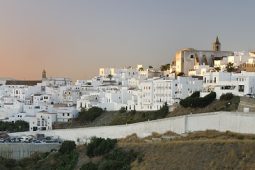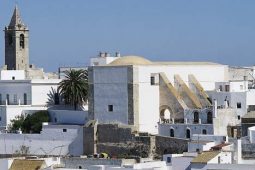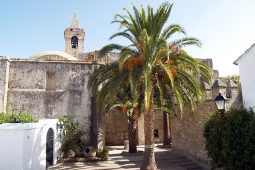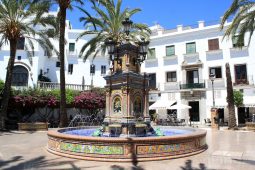Vejer is one of these unique places which retain a special magic. You’ll want to linger for a while to enjoy its charming, mysterious corners.
Vejer is a town full of history, with the exotic atmosphere of its Arab influence, present in its courtyards, arches, the old city walls and the decoration of its restaurants, terraces, shops…
Walking along the winding streets you will find stately houses, secret corners, handmade basketry products, terraces full of magic …
Also highly recommended is having a cup of wine, beer or one of the cocktails in one of the numerous terraces, where it´s possible to enjoy a spectacular sunset watching its white houses and large areas of the Andalusian countryside.
Children will love exploring the winding streets of Vejer, climbing walls, hiding in the alleys, running up and downstairs, passing through its arches to find secret courtyards and gardens … You can play hide and seek through the streets of the historic area (with some precaution) since many of the streets have traffic restrictions. Vejer is a perfect place to enjoy with your children in Spain.
You can also book tours riding a donkey, or arrange excursions for whale watching near the Gibraltar strait. Vejer is a strategic point from which visit most of the coast of Cadiz, as Conil de la Frontera, Zahora, El Palmar, Zahara, Barbate and the beautiful Sierra de Grazalema.
You can visit Vejer all year round, but it’s better to go when the weather is nice, as you will have access to more outdoors activities, so we reccomend from May to mid-October.
MONUMENTS
The fortified walls
You can still trace the outline of these ancient monuments and in places they appear proud & defensive & in others disappear into homes & you’ll see somebodys washing being hung on the ramparts. Heavily restored in places the walls were built in the 15th.C. as part of the defensive investment after the Christian reconquest of the region. The best sections of restored walls are to be found at the top end of Calle Eduardo Shelly next to the north face of the church, in the Judería including the old gates of Puerta Cerrada and the entire section from the gate of Sancho el Bravo to the Plaza de España including the Casa del Mayorazgo (see below).
The Archways
A notable feature are the various arches that lead into the old town through the walls. Unlike in many other towns all the original gateways still exist & form a feature of the everyday life of Vejer.
- Sancho IV gate: The oldest & best preserved gate to the old town.
- Villa´s gate : The main archway into Vejer in the Plaza de España. Originally this was the termination of the old Roman road up from La Barca.
- Segur´s gate : The lowest and best fortified of the archways squeezed between the fortifications & the church.
- Closed gate : Traditionally the ‘closed gate’ as it was supposedly most susceptible to attack form the south.
The Castle
The old moorish built ‘alcazaba’ is tucked away down a narrow backstreet. Only one facade reveals this monuments history as the town has been built right around the edifice. A classic 11th.C. ogee arch leads into a jasmine scented courtyard. Beyond this there is not much to see as now much of the castle is residential. If you are lucky the local scouts who have their den here will show you around the ramparts.
The Church
Built on the site of the old mosque the minaret is still standing now although now crowned with a bell tower. Under the church is the outstanding ‘aljibe’ or water deposit built by the moors (not open to the public) so large that it can be navigated around in a small dinghy. The church itself has two contrasting styles. Towards the front of the main aisle is visigothic while the remainder is mudejar. The interior was completely bespoiled during the Civil War & little remains of the churches riches. Its simplicity however is most attractive. Take a close look at the burial niches along the outside north wall of the church.
Plaza de España or ‘Plaza de los Pescaitos’
A most attractive plaza this is a favourite spot for visitors & locals alike. Ringed with date palms with some immense bouganvilla bushes as a backdrop the Plaza de los Pescaitos (Plaza of the Little Fish), gets its name from the goldfish that used to swim around the fountain. The ornate fountain is not as old as it seems and dates back to the 1920’s. Decorated with bright ceramics & 4 spouting frogs you will find an almost replica fountain in the main plaza of Algeciras. The town hall (‘Ayuntamiento’) overlooks the square & a notable feature is the facade of the 16th.C. Court (below)
Court
One of Vejer’s most notable privately owned buildings is the intriguing Casa del Juzgado (home both to Vejer’s magistrates office and the Casa del Califa hotel). The main building dates back to 1527 although the façade was added almost a century later. Built on the site of a 10th. Century arab building you can still see the aljibe and remaining stairs from this era by visiting the hotel itself.
Mayorazgo´s house
Next to the Gate of Sancho el Bravo you will find this large private house now a ‘patio de vecinos’ with 5 families living around its large central courtyard. Visiting the medieval tower is free, just walk through the courtyard and leave a donation on your way out. This is a good opportunity to see how families communally live, at one time sharing not only common living spaces but kitchens and toilets. From the tower you will see fabulous views of town, country and coast plus a splendid birds eye view of the Plaza de España. Open every day during daylight hours.




